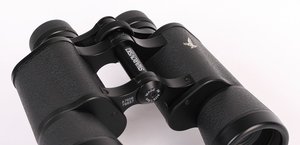Vortex Viper HD 10x50 (2018)
In 2011 that series got a successor in the form of the Viper HD line and one of binoculars belonging to it, namely the 10×42 device, we've already tested. I admit we described it in superlatives only.
 |
In the case of the 10×50 model you can notice both positive and negative changes. What's the most important, though, the field of view increased from 5.3 to 6.6 degrees and finally that value befits a good 10x50 class instrument. Unfortunately the eye relief distance decreased from 19.5 to 16 mm and the minimum focusing distance increased from 2.7 to 2.9 meters. Still, the producers didn't increase the price of new models. The following chart presents a comparison between all versions of the Viper 10x50.
What else? Producers boast of low dispersion HD glass and XR Fully Multi-Coated optics on all air-to-glass surfaces. Apart from that, the Schmidt-Pechan prisms are coveredy by phase correction and dielectric multi-coatings and outer elements are protected from scratches, humidity and grease by hydrophobic ArmorTek coatings.
 |
| Magnification | Lens diameter | Angular field of view | Prisms | Eye relief | Weight | Price |
|---|---|---|---|---|---|---|
| 10 | 50 | 115/1000(6.6o) | BaK-4/roof | 16 mm | 805 g | 2469 PLN |
Summary
Pros:
- solid and stylish chassis,
- wide field of view,
- good control of astigmatism,
- slight coma,
- very low brightness loss on the edge of the field,
- good quality BaK-4 prisms,
- proper blackening and cleanliness inside the instrument,
- good quality anti-reflection coatings that cover all air-to-glass surfaces,
- lifetime warranty.
- too low trasmission for a pair of binoculars at this price point,
- a bit too high chromatic aberration on the edge of the field of view.
 |
The situation changed diametrically in 2018, when the new Vipers were presented. The 10x50 model got a field of 6.6 degrees (or even 6.7 degrees according to our measurements), an excellent result. What's more, all the optics came inside a very shapely chassis which weight exceeds slightly 800 grams. After learning that much we wanted to take a closer look at the Viper HD 10x50 without any objections.
 Vortex Viper 10x42 HD and Vortex Viper 10x50 HD. |
 |
As you see, the Viper HD 10x50 fits a certain market gap – it is an interesting option for those who want to buy a roof prism 10x50 pair of binoculars with 'normal' parameters and good optical properties but they don't want to spend more than about 1000 USD. So far, the choice in that segment was really poor and, as the Meopta Meostar is no longer produced in the 10x50 version, the Viper really doesn't have many serious rivals.
By the way, it's a pity the 10x50 class has been so neglected lately. While you see many new 8x42 and 10x42 models launched by many different producers the 10x50 binoculars are kind of forgotten, even though their parameters are the most universal ones. Vortex didn't make such a mistake and, as they offer the well-put-together and optically efficient Viper 10x50 HD, we don't doubt they will reap the fruit of their labour.

















